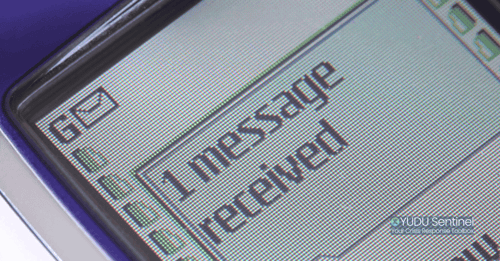Why SMS Remains the Bedrock of Emergency Mass Notifications
The Cost of Delays in Incident Response
In a crisis, every second counts. Whether responding to a cyberattack, an operational disruption, a security incident, or a natural disaster, delays in communication and decision-making can lead to severe consequences. Prolonged downtime, financial losses, reputational damage, and, in some cases, risks to human life are all potential outcomes of an uncoordinated response.
The challenge many organisations face is that traditional communication and response mechanisms - email, messaging apps like Microsoft Teams, or even manual phone trees - are not built for crisis scenarios. Information gets siloed, key personnel may be unreachable, and decision-making suffers due to incomplete or delayed updates.
This is where real-time incident management technology, like Sentinel, plays a pivotal role. By leveraging advanced features such as out-of-band communication, mass alerting, and real-time situational awareness, organisations can significantly reduce response times and improve resilience.
Key Real-Time Features That Improve Incident Response
1. Out-of-Band Communication: Ensuring Secure, Reliable Contact
During a major incident, organisations cannot afford to rely on compromised or inaccessible communication channels. Sentinel provides out-of-band communication, ensuring that teams can securely coordinate their response even when corporate networks, email, or traditional messaging apps are unavailable or unsafe to use.
Use Case: Financial Sector Cyberattack
A financial institution experiences a cyberattack, potentially compromising its internal email system. Using Sentinel’s PiNG messaging and secure Video Crisis Rooms within Sentinel Spaces, the incident response team can communicate outside the compromised network, ensuring a coordinated, confidential response to contain the threat.
2. Mass Alerting: Rapid Notification Across Channels
When a crisis unfolds, reaching the right people instantly is critical. Sentinel’s mass alerting system allows organisations to send urgent messages across multiple channels, including SMS, push notifications, email, and voice calls. With real-time delivery tracking and two-way communication, organisations can confirm message receipt and collect responses for situational awareness.
Use Case: University Fire Evacuation
A university must evacuate a building due to a fire alarm. Using Sentinel, administrators send instant mass notifications to staff and students, providing real-time updates on evacuation routes and safe assembly points. Two-way responses allow faculty members to confirm when all students have exited safely.
3. Situational Awareness: The Power of Live Information
Real-time situational awareness is key to effective decision-making. Sentinel provides live reporting on message delivery, an incident reporting line, and video conferencing capabilities to give response teams a dynamic, real-time view of the situation. This ensures that decisions are based on the latest available data rather than outdated reports.
Use Case: Logistics Disruptions During Extreme Weather
A logistics company faces an unexpected snowstorm that disrupts delivery routes. Using Sentinel’s situational awareness tools, dispatchers can get inbound updates from teams on the ground to monitor road closures and heavy traffic in real time, rerouting drivers based on up-to-the-minute data. This prevents costly delays and ensures deliveries reach their destinations with minimal disruption.
4. Seamless Escalation from Chat to Video Conferencing
Text-based chat is valuable but often insufficient in high-stakes crisis management. Sentinel enables teams to seamlessly escalate from chat to secure Video Crisis Rooms within Sentinel Spaces. Features such as screen sharing, and interactive whiteboarding allow teams to coordinate efficiently in real time.
Use Case: IT Security Team Responding to a Ransomware Attack
An IT security team detects a ransomware breach. Instead of exchanging fragmented messages over email or chat, the team immediately escalates to a secure Sentinel Video Crisis Room, where they review attack vectors, screen-share security logs, and make real-time mitigation decisions. This rapid coordination minimises downtime and data loss.
The Measurable Impact of Faster Incident Response
Investing in real-time incident management technology translates directly into improved resilience. Faster decision-making reduces downtime, prevents financial and reputational damage, and enhances compliance with industry regulations. All of which delivers a positive ROI on your investment in a Sentinel platform.
For example, financial institutions preparing for DORA compliance benefit from Sentinel’s audit trails, ensuring that all incident communications and actions are securely logged for post-incident analysis. Similarly, enterprises under UK FCA regulations can leverage Sentinel’s out-of-band communication to mitigate the risks associated with off-channel communications.
Conclusion: Why Real-Time Incident Management Is No Longer Optional
As threats grow more sophisticated and regulatory pressures increase, organisations must prioritise real-time incident response. Sentinel provides the secure, fast, and reliable tools needed to mitigate crises effectively. Whether it’s secure messaging, mass notifications, or situational awareness, Sentinel helps organisations respond faster, coordinate better, and maintain business continuity in the face of disruption.
The time for reliance on traditional, slow-moving communication methods is over. With Sentinel, organisations can take control of crisis response and ensure they are prepared for whatever challenges lie ahead.
Is your organisation ready for real-time incident management? Contact us to learn more about how Sentinel can improve your resilience.
Tags:

14 Feb 2025


